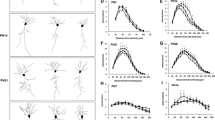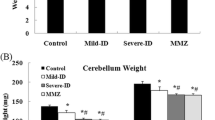Abstract
Iodine deficiency (ID) during development results in dysfunction of the central nervous system (CNS) and affects psychomotor and motor function. It is worth noting that maternal mild and marginal ID tends to be the most common reason of preventable neurodevelopmental impairment, via a mechanism that has not been elucidated. Therefore, our aim was to study the effects of developmental mild and marginal ID on the differentiation of cerebellar granule cells (GCs) and investigate the activation of BMP-Smad1/5/8 signaling, which is crucial for the development and differentiation of cerebellum. Three developmental rat models were created by feeding dam rats with a diet deficient in iodine and deionized water supplemented with potassium iodide. Our results showed that different degrees of ID inhibited and delayed the differentiation of cerebellar GCs on postnatal day (PN) 7, PN14, and PN21. Moreover, mild and severe ID reduced the expression of BMP2 and p-Smad1/5/8, and increased the levels of Id2 on PN7, PN14, and PN21. However, marginal ID rarely altered expression of these proteins in the offspring. Our study supports the hypothesis that mild and severe ID during development inhibits the differentiation of cerebellar GCs, which may be ascribed to the down-regulation of BMP-Smad1/5/8 signaling and the overexpression of Id2. Furthermore, it was speculated that maternal marginal ID rarely affected the differentiation of cerebellar GCs in the offspring.









Similar content being viewed by others
References
Puig-Domingo M, Vila L (2013) The implications of iodine and its supplementation during pregnancy in fetal brain development. Curr Clin Pharmacol 8:97–109
Zimmermann MB (2009) Iodine deficiency. Endocr Rev 30:376–408
Zimmermann MB, Andersson M (2012) Update on iodine status worldwide. Curr Opin Endocrinol Diabetes Obes 19:382–387
Alzoubi KH, Gerges NZ, Aleisa AM, Alkadhi KA (2009) Levothyroxin restores hypothyroidism-induced impairment of hippocampus-dependent learning and memory: behavioral, electrophysiological, and molecular studies. Hippocampus 19:66–78
Dong J, Liu W, Wang Y, Hou Y, Xi Q, Chen J (2009) Developmental ID resulting in hypothyroidism reduces hippocampal ERK1/2 and CREB in lactational and adolescent rats. BMC Neurosci 10:149
Morreale de Escobar G, Obregon MJ, Escobar del Rey F (2000) Is neuropsychological development related to maternal hypothyroidism or to maternal hypothyroxinemia? J Clin Endocrinol Metab 85:3975–3987
Stagnaro-Green A, Abalovich M, Alexander E, Azizi F, Mestman J, Negro R, Nixon A, Pearce EN et al (2011) Guidelines of the American Thyroid Association for the diagnosis and management of thyroid disease during pregnancy and postpartum. Thyroid 21(10):1081–1125
Bath SC, Steer CD, Golding J, Emmett P, Rayman MP (2013) Effect of inadequate iodine status in UK pregnant women on cognitive outcomes in their children: results from the Avon Longitudinal Study of Parents and Children (ALSPAC). Lancet 382:331–337
Finken MJ, van Eijsden M, Loomans EM, Vrijkotte TG, Rotteveel J (2013) Maternal hypothyroxinemia in early pregnancy predicts reduced performance in reaction time tests in 5- to 6-year-old offspring. J Clin Endocrinol Metab 98:1417–1426
Wang Y, Wei W, Song B, Wang Y, Dong J, Min H, Chen J (2014) Developmental hypothyroxinemia caused by mild iodine deficiency leads to HFS-induced LTD in rat hippocampal CA1 region: involvement of AMPA receptor. Mol Neurobiol 50(2):348–357
Wang Y, Wei W, Wang Y, Dong J, Song B, Min H, Teng W, Chen J (2013) Neurotoxicity of developmental hypothyroxinemia and hypothyroidism in rats: impairments of long-term potentiation are mediated by phosphatidylinositol 3-kinase signaling pathway. Toxicol Appl Pharmacol 271(2):257–265
Wei W, Wang Y, Wang Y, Dong J, Min H, Song B, Teng W, Xi Q et al (2013) Developmental hypothyroxinaemia induced by maternal mild iodine deficiency delays hippocampal axonal growth in the rat offspring. J Neuroendocrinol 25(9):852–862
Wei W, Wang Y, Dong J, Wang Y, Min H, Song B, Shan Z, Teng W et al (2014) Hypothyroxinemia induced by maternal mild iodine deficiency impairs hippocampal myelinated growth in lactational rats. Environ Toxicol. doi:10.1002/tox.21997
Wang Y, Wang Y, Dong J, Wei W, Song B, Min H, Yu Y, Lei X et al (2014) Developmental hypothyroxinemia and hypothyroidism reduce proliferation of cerebellar granule neuron precursors in rat offspring by downregulation of the sonic hedgehog signaling pathway. Mol Neurobiol 49(3):1143–1152
Wang Y, Wang Y, Dong J, Wei W, Song B, Min H, Teng W, Chen J (2014) Developmental hypothyroxinaemia and hypothyroidism limit dendritic growth of cerebellar Purkinje cells in rat offspring: involvement of microtubule-associated protein 2 (MAP2) and stathmin. Neuropathol Appl Neurobiol 40(4):398–415
Ferreir SM, Navarro AM, Magalhães PK, Maciel LM (2014) Iodine insufficiency in pregnant women from the State of São Paulo. Arq Bras Endocrinol Metabol 58:282–287
Méndez-Villa L, Elton-Puente JE, Solís-S JC, Sampson-Zaldívar E, García-G C, Villalobos P, Colarossi A, García OP et al (2014) Iodine nutrition and thyroid function assessment in childbearing age women from Queretaro, Mexico. Nutr Hosp 29:204–211
World Health Organization/UNICEF/ICCIDD (2007) Assessment of ID disorders and monitoring their elimination: a guide for programme managers, 3rd edn. World Health Organization, Geneva, Available from http://whqlibdoc.who.int/publications/2007/9789241595827_eng.pdf
Versloot PM, Schröder-van der Elst JP, van der Heide D, Boogerd L (1998) Effects of marginal iodine deficiency on thyroid hormone production, distribution and transport in nonpregnant and near term pregnant rats. Eur J Endocrinol 138(6):713–718
Chantoux F, Francon J (2002) Thyroid hormone regulates the expression of NeuroD/BHF1 during the development of rat cerebellum. Mol Cell Endocrinol 194(1–2):157–163
Behesti H, Marino S (2009) Cerebellar granule cells: insights into proliferation, differentiation, and role in medulloblastoma pathogenesis. Int J Biochem Cell Biol 41(3):435–445
Kumar K, Patro N, Patro I (2013) Impaired structural and functional development of cerebellum following gestational exposure of deltamethrin in rats: role of reelin. Cell Mol Neurobiol 33(5):731–746
Hsieh CP, Chang WT, Lee YC, Huang AM (2014) Deficits in cerebellar granule cell development and social Interactions in CD47 knockout mice. Dev Neurobiol. doi:10.1002/dneu.22236
Espinosa JS, Luo L (2008) Timing neurogenesis and differentiation: insights from quantitative clonal analyses of cerebellar granule cells. J Neurosci 28(10):2301–2312
Podkowa M, Christova T, Zhao X, Jian Y, Attisano L (2013) p21-Activated kinase (PAK) is required for Bone Morphogenetic Protein (BMP)-induced dendritogenesis in cortical neurons. Mol Cell Neurosci 57:83–92
Liu H, Jia D, Li A, Chau J, He D, Ruan X, Liu F, Li J et al (2013) p53 regulates neural stem cell proliferation and differentiation via BMP-Smad1 signaling and Id1. Stem Cells Dev 22(6):913–927
Shi Y, Massague J (2003) Mechanisms of TGF-β signaling from cell membrane to the nucleus. Cell 113(6):685–700
Sabo JK, Kilpatrick TJ, Cate HS (2009) Effects of bone morphogenic proteins on neural precursor cells and regulation during central nervous system injury. Neurosignals 17(4):255–264
Ying QL, Nichols J, Chambers I, Smith A (2003) BMP induction of Id proteins suppresses differentiation and sustains embryonic stem cell self-renewal in collaboration with STAT3. Cell 115:281–292
Li W, Cogswell CA, LoTurco JJ (1998) Neuronal differentiation of precursors in the neocortical ventricular zone is triggered by BMP. J Neurosci 18:8853–8862
Varley JE, Maxwell GD (1996) BMP-2 and BMP-4, but not BMP-6, increase the number of adrenergic cells which develop in quail trunk neural crest cultures. Exp Neurol 140:84–94
Miyazono K, Miyazawa K (2002) Id: a target of BMP signaling. Sci STKE 2002(151):pe40
Lyden D, Young AZ, Zagzag D, Yan W, Gerald W, O'Reilly R, Bader BL, Hynes RO et al (1999) Id1 and Id3 are required for neurogenesis, angiogenesis and vascularization of tumour xenografts. Nature 401(6754):670–677
Neuman T, Keen A, Zuber MX, Kristjansson GI, Gruss P, Nornes HO (1993) Neuronal expression of regulatory helix-loop-helix factor Id2 gene in mouse. Dev Biol 60(1):186–195
Shimokawa N, Yousefi B, Morioka S, Yamaguchi S, Ohsawa A, Hayashi H, Azuma A, Mizuno H et al (2014) Altered cerebellum development and dopamine distribution in a rat genetic model with congenital hypothyroidism. J Neuroendocrinol 26(3):164–175
Oyanagi K, Negishi T, Tashiro T (2014) Action of thyroxine on the survival and neurite maintenance of cerebellar granule neurons in culture. J Neurosci Res. doi:10.1002/jnr.23519
Manzano J, Cuadrado M, Morte B, Bernal J (2007) Influence of thyroid hormone and thyroid hormone receptors in the generation of cerebellar gamma-aminobutyric acid-ergic interneurons from precursor cells. Endocrinology 148(12):5746–5751
Reeves PG, Nielsen FH, Fahey GC Jr (1993) AIN-93 purified diets for laboratory rodents: final report of the American Institute of Nutrition ad hoc writing committee on the reformulation of the AIN-76A rodent diet. J Nutr 123:1939–1951
Chung SH, Kim CT, Jung YH, Lee NS, Jeong YG (2010) Early cerebellar granule cell migration in the mouse embryonic development. Anat Cell Biol 43(1):86–95
Mullen RJ, Buck CR, Smith AM (1992) NeuN, a neuronal specific nuclear protein in vertebrates. Development 116(1):201–211
Angley C, Kumar M, Dinsio KJ, Hall AK, Siegel RE (2003) Signaling by bone morphogenetic proteins and Smad1 modulates the postnatal differentiation of cerebellar cells. J Neurosci 23(1):260–268
Pearce EN, Andersson M, Zimmermann MB (2013) Global iodine nutrition: where do we stand in 2013? Thyroid 23:523–528
Saira S, Khattak RM, Rehman AU, Khan AA, Khattak MNK (2014) Prevalence of goiter and iodine status in 6–12 years school children and pregnant women of district Charsadda, Pakistan. Acta Endocrinol (Buc) 10:65–75
Andersson M, Karumbunathan V, Zimmermann MB (2012) Global iodine status in 2011 and trends over the past decade. J Nutr 142:744–750
Clifton VL, Hodyl NA, Fogarty PA, Torpy DJ, Roberts R, Nettelbeck T, Ma G, Hetzel B (2013) The impact of iodine supplementation and bread fortification on urinary iodine concentrations in a mildly iodine deficient population of pregnant women in South Australia. Nutr J 12:32
Farwell AP, Dubord-Tomasetti SA, Pietrzykowski AZ, Stachelek SJ, Leonard JL (2005) Regulation of cerebellar neuronal migration and neurite outgrowth by thyroxine and 3,3′,5′-triiodothyronine. Brain Res Dev Brain Res 154(1):121–135
Cheng SY, Leonard JL, Davis PJ (2010) Molecular aspects of thyroid hormone actions. Endocr Rev 31(2):139–170
Di Liegro I (2008) Thyroid hormones and the central nervous system of mammals. Mol Med Rep 1(3):279–295
Bond AM, Bhalala OG, Kessler JA (2012) The dynamic role of bone morphogenetic proteins in neural stem cell fate and maturation. Dev Neurobiol 72:1068–1084
Rios I, Alvarez-Rodriguez R, Marti E, Pons S (2004) Bmp2 antagonizes sonic hedgehog-mediated proliferation of cerebellar granule neurons through Smad5 signalling. Development 131:3159–3168
Anitha M, Shahnavaz N, Qayed E, Joseph I, Gossrau G, Mwangi S, Sitaraman SV, Greene JG et al (2010) BMP2 promotes differentiation of nitrergic and catecholaminergic enteric neurons through a Smad1-dependent pathway. Am J Physiol Gastrointest Liver Physiol 298(3):G375–G383
Berenguer J, Herrera A, Vuolo L, Torroba B, Llorens F, Sumoy L, Pons S (2013) MicroRNA 22 regulates cell cycle length in cerebellar granular neuron precursors. Mol Cell Biol 33(14):2706–2717
Martel J, Cayrou C, Puymirat J (2002) Identification of new thyroid hormone-regulated genes in rat brain neuronal cultures. Neuroreport 13(15):1849–1851
Tong KK, Kwan KM (2013) Common partner smad-independent canonical bone morphogenetic protein signaling in the specification process of the anterior rhombic lip during cerebellum development. Mol Cell Biol 33(10):1925–1937
Biggs J, Murphy EV, Israel MA (1992) A human Id-like helix-loop-helix protein expressed during early development. Proc Natl Acad Sci U S A 89:1512–1516
Neuman T, Keen A, Zuber MX, Kristjansson GI, Gruss P, Nornes HO (1993) Neuronal expression of regulatory helix-loop-helix factor Id2 gene in mouse. Dev Biol 160:186–195
Tzeng SF, de Vellis J (1998) Id1, Id2, and Id3 gene expression in neural cells during development. Glia 24(4):372–381
Gleichmann M, Buchheim G, El-Bizri H, Yokota Y, Klockgether T, Kugler S, Bahr M, Weller M et al (2002) Identification of inhibitor-of-differentiation 2 (Id2) as a modulator of neuronal apoptosis. J Neurochem 80:755–762
Tzeng SF (2003) Inhibitors of DNA binding in neural cell proliferation and differentiation. Neurochem Res 28(1):45–52
Acknowledgments
This work was supported by the National Natural Science Foundation of China (grant number 81102126) and Important Platform of Science and Technology for the Universities in Liaoning Province (grant number 16010).
Conflict of Interest
The authors declare that they have no competing interests.
Author information
Authors and Affiliations
Corresponding authors
Additional information
Jie Chen is the first corresponding author and Weiping Teng is the co-corresponding author.
Rights and permissions
About this article
Cite this article
Dong, J., Lei, X., Wang, Y. et al. Different Degrees of Iodine Deficiency Inhibit Differentiation of Cerebellar Granular Cells in Rat Offspring, via BMP-Smad1/5/8 Signaling. Mol Neurobiol 53, 4606–4617 (2016). https://doi.org/10.1007/s12035-015-9382-0
Received:
Accepted:
Published:
Issue Date:
DOI: https://doi.org/10.1007/s12035-015-9382-0




